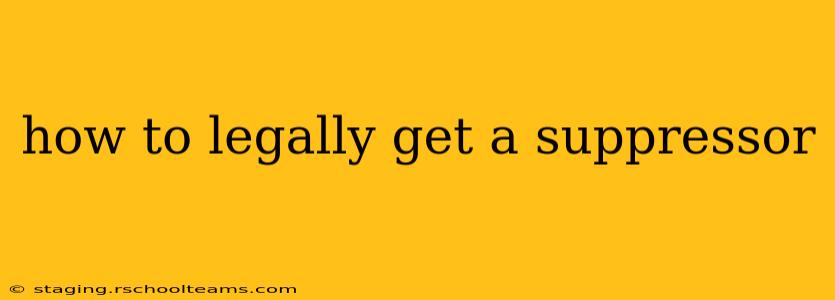The process of legally acquiring a suppressor in the United States can seem daunting, but by understanding the regulations and following the proper procedures, it's achievable. This guide breaks down the steps involved, ensuring you navigate the legal landscape correctly.
Understanding the NFA and Suppressor Regulations
The primary legislation governing suppressor ownership is the National Firearms Act (NFA) of 1934. This act classifies suppressors as "firearms" requiring registration with the Bureau of Alcohol, Tobacco, Firearms and Explosives (ATF). This means there's more involved than simply purchasing a suppressor from a dealer. Key aspects of the NFA relevant to suppressor acquisition include:
- Serial Numbers: All suppressors are serialized, and this number is crucial throughout the registration process.
- Background Checks: A thorough background check is conducted through the ATF. This is similar to a standard firearm purchase, but more rigorous due to the NFA's classifications.
- Tax Stamp: A significant tax ($200 as of October 26, 2023) is levied on the suppressor. This tax is a non-refundable fee, and payment is part of the ATF registration process.
- Waiting Period: There's a waiting period (which can vary) between application submission and approval. This time is necessary for the ATF to complete the background check and process the paperwork.
Steps to Legally Purchase a Suppressor
-
Determine Eligibility: Before beginning the process, confirm your eligibility. Federal and state laws govern suppressor ownership, and prohibitions exist for convicted felons, individuals with specific misdemeanor convictions, and those subject to certain restraining orders. Thoroughly research your state and local regulations as these can vary.
-
Choose a Licensed Dealer: Select a dealer licensed by the ATF to sell NFA items. These dealers are familiar with the paperwork and procedures, providing guidance and assistance.
-
Complete ATF Form 4: This is the crucial application form for registering your suppressor with the ATF. Accuracy is paramount; any errors can cause significant delays or rejection. The dealer will generally guide you through completing this form.
-
Fingerprint and Photograph: You will need to provide your fingerprints and a photograph as part of the application. Many ATF-licensed dealers offer this service.
-
Pay the Tax Stamp: Remit the $200 tax to the ATF. Your dealer will usually handle this transaction.
-
Submit the Application: Your dealer will submit the completed Form 4, fingerprints, photograph, and tax payment to the ATF.
-
Awaiting Approval: The ATF processes your application. The waiting period can fluctuate greatly depending on current ATF workload; it's prudent to expect several months or potentially longer.
-
Receive Approval and Take Possession: Once the ATF approves your application, you can take possession of your suppressor.
Important Considerations:
- State Laws: Always check your state's laws concerning suppressor ownership. Some states have additional restrictions or outright bans.
- Legal Counsel: Consult with a legal professional specializing in firearms law if you have any questions or concerns.
- Responsible Ownership: Safe and responsible handling and storage of suppressors are crucial. Familiarize yourself with all safety guidelines.
Acquiring a suppressor legally requires patience and attention to detail. By understanding the regulations and following the outlined steps, you can responsibly and legally own a suppressor. Remember that this information is for general guidance only, and consulting with an expert in firearms law is always recommended.
